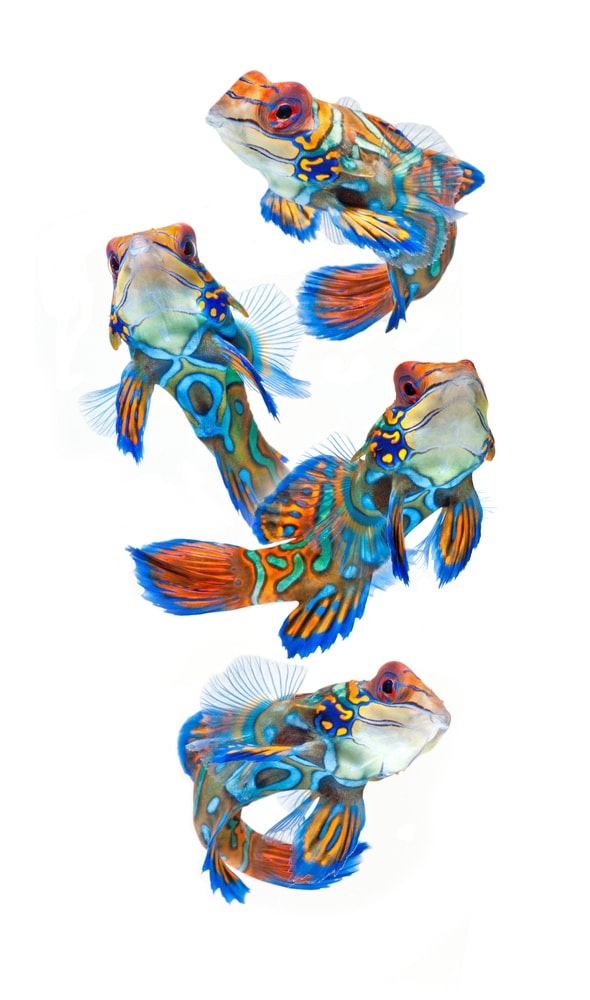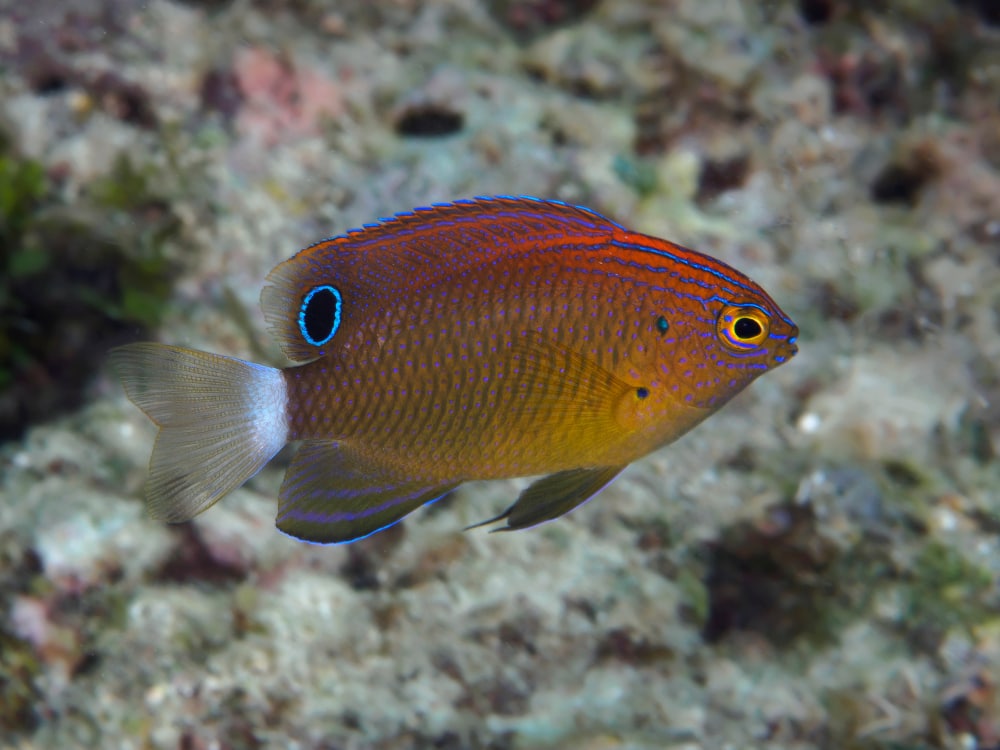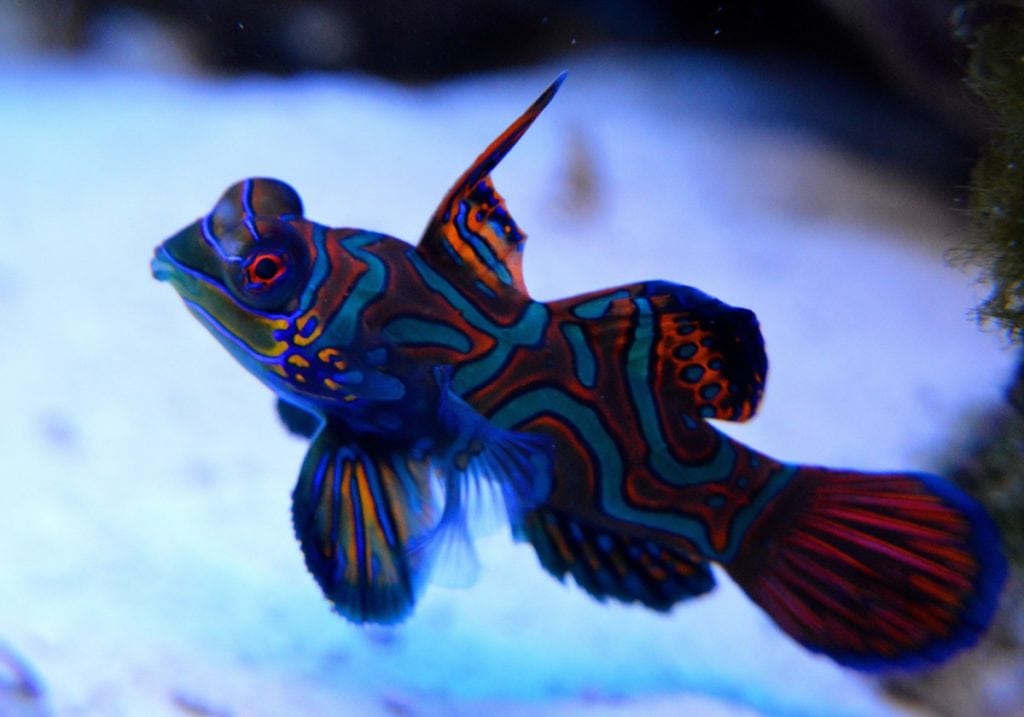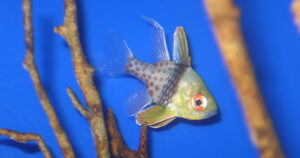I should have done this! I should have done that! Throughout your experience in the saltwater aquarium and reef hobby, you will be finding yourself commonly saying these things. Maybe you did not dip your corals, or you bought the wrong additives, or maybe you added a fish without properly preparing your tank. This fish could easily be the Green Mandarin (Synchiropus splendidus), especially because of its popularity, but also specific tank requirements. There are many things one can do to their aquarium to ensure that it is suitable for a Mandarin. These fish are stunning and it would be a shame to be unsuccessful with keeping one.
 Dietary Needs
Dietary Needs
If your tank is not yet set up or is going through the cycling process, there are decisions you can make that will make keeping a dragonet setup easier later on.
First, it is important to understand what challenges are involved with caring for one of these fish. The biggest factor is the diet of the fish. Dragonets are known to be finicky eaters. They do not eat dry food, and only some will accept frozen food, such as mysis or brine. The most reliable option is to feed them live foods that provide the most nutrition and stability. The issue with feeding live foods is that it is not ideal to feed day to day, as it can get expensive. What you can do to your tank early on to avoid this issue is seed the tank with a sustainable source of live food. You can do this at any point, but it is best to do it towards the end of cycling before any fish are added. This way they have time to reproduce and populate the tank, without fish eating them.
You will be adding tiny bug-like crustaceans called copepods, which are available at algaebarn.com. There are variations such as Tisbee pods and Apocalypse pods, but they all generally provide for the same purpose, which is to feed your Mandarin Dragonet.
It is best to add copepods to a refugium area where they are safe from any predators, so they can continue to reproduce even after you add fish. It is important to have your refugium as the last stage filtration so that the copepods will go directly into your tank and not get filtered out. In the refugium, you will need some sort of media or rock, as well as some sort of macroalgae. The macroalgae is not required, but it is beneficial to have in a refugium.
[Copepods]
Once your refugium is set up and running, add the copepods to it with the pumps off and let it sit for 12-24 hours. You can also add copepods to your tank by simply pouring them in or using a turkey baster to squirt them onto the rock and in the sandbed.
If your tank is already running and has fish in it, it is not too late to add copepods to prepare it for the addition of a Mandarin Dragonet. You can follow similar steps as if it were first being set up. The biggest difference is that you will want to be sure to add any copepods to your tank at night and not during the day. This way the copepods can settle in while the fish are sleeping and not get eaten. Again, you will want to be sure all your pumps off as well.
If a refugium is not available, you can also use a small plastic container called a “pod hotel” as an alternate option. It is simply a plastic container with several holes cut all around it and rock and rubble in the inside. Then it is placed in the display part of the tank and copepods are put inside of it. The pod hotel is not as effective as a refugium, but it is an option.
Now, wait about a week or more for the copepods to reproduce, and you are ready to add a dragonet, or are you?
Tank Mates
There a few other important things to do before you add your new Green Mandarin Goby. You need to be sure that the dragonet’s tank mates are compatible with it. Dragonet’s do not generally do good in a tank with other fish of its kind. They can be aggressive with each other, especially if they are the same sex. It is possible to pair two Mandarin Dragonets of opposite sexes, but then the issue is the possibility of not enough food to support the two. One dragonet could easily wipe out a non-sustained population of copepods, but when you add another, that rate is doubled.
Fish such as wrasses can also be a problem for this same reason. A lot of wrasses are hunters and can out-compete the dragonet for food. If you want to have another fish that will feed off your copepod population, it is important to ensure that the population is sustained; it is best to wait for the tank to mature.
Tank mates such as eels, lobsters, and large crabs are not best with dragonets, as they are possible predators of the dragonet if they are hungry enough. Green mandarins are slow, so if an eel or large crab got hungry enough, they could easily prey upon the dragonet. Just as aggressive crustaceans do not do well with this fish, aggressive fish are the same. Avoid any kind of predatory fish and keep to peaceful tank mates.
Having the proper tank mates for your Green Mandarin Dragonet setup is important because it keeps the fish less stressed, which will allow it to live longer and healthier.
Tank Size
Green Mandarin Dragonets are small fish; they can grow up to four inches at the maximum length. That being said, it would seem reason reasonable for a mandarin setup to be in a 20-gallon or 30-gallon nano  tank. That is not so, for one main reason, which relates to the same thing that makes this fish difficult to care for. That one reason being diet. In a smaller tank, you can only have an amount of rock surface area in proportion to the size of the tank. When you have a small amount of surface area within the tank, it also means a limited sized habitat for copepods, which will be the dragonet’s main source of food. If your dragonet is accepting frozen brine or mysis as food, you can then just feed more of that as an alternative to make up for the shortage of copepods. The issue with this is that you will be putting more nutrients in your aquarium system, which will bring other unwanted issues.
tank. That is not so, for one main reason, which relates to the same thing that makes this fish difficult to care for. That one reason being diet. In a smaller tank, you can only have an amount of rock surface area in proportion to the size of the tank. When you have a small amount of surface area within the tank, it also means a limited sized habitat for copepods, which will be the dragonet’s main source of food. If your dragonet is accepting frozen brine or mysis as food, you can then just feed more of that as an alternative to make up for the shortage of copepods. The issue with this is that you will be putting more nutrients in your aquarium system, which will bring other unwanted issues.
While the Green Mandarin Dragonet may be small enough to put in a small sized tank, it is best to put it in a tank 50-gallons or larger. Your tank should have 50 pounds or more worth of rock in the display, depending on the size of the tank, and a refugium that is 1-5 gallons or larger. Also, bigger tanks can handle more feeding if you find it necessary to do so.
Basic Parameter Needs
As for any fish or coral you add to your saltwater aquarium system, you will need to be sure your tank is fully cycled and your parameters are acceptable and stable before adding a dragonet. This fish is hardy and can handle some swings in parameters, but you have to aim for your parameters to be as stable as possible. This way you can eliminate stress from your fish in that sense.
That’s it! After following these guidelines, your aquarium will be ready for the addition of a Green Mandarin Dragonet and you can begin caring for it and watching it live within your aquarium or reef tank.
[Copepods]






Chris Becerra says
Thanks it’s important to make your your aquarium is set up to keep this Type a fish thanks for helping guys
kyevey says
I wish I had this information years ago when I first tried dragonettes.
Ryan says
Agree with having a larger tank, the bigger the better for them, just means more for them to snack on. I have kept my previous dragonet with an eel though, a golden dwarf. They got along great, as the mandarin was WAY to big for the eel to think about eating, but my eel was peaceful with my smaller fish regardless.
Linh Nguyen says
Great in depth info on care for Mandarins!
Brandon says
Very important information to new people wanting to keep the Mandarin! Excellent job as always to everyone at Algae Barn!
Richard says
Great article
Victoria says
I’ve had my Mandarin for a year next month & spent alot of time researching before I got her. This is a great & very informative article for people interested in getting one of these beautiful fish!
Victoria Brewer says
Great info!
Compy Ginorio says
Very helpful hints at the moment of considering adding a Mandarin to our DT’s.
Amie Holmes says
Algae Barn is the best for all Macroalgae!
Angel Alcay says
Having a safe place for pods to reproduce is a must for me
hwarrenfeltz says
Awesome
Keysha says
This is valuable information.
Keysha says
All need to know information.
fireninja2k11 says
Great info about Mandarins!!
fireninja2k11 says
hi great info on this!
fireninja2k11 says
Great article!
Robert Blevins says
My tank is ready for a pair of these beauties.
Robert Blevins says
The pods need a refugium of sorts yes?
PAT HILLIARD says
Not necessarily. I’ve had great success using tightly branched coral pieces in my rockwork. These chunks of coral are branched too tightly for fish to enter, but the pods hide in the branches and crevices between where they can reproduce unmolested. I had to keep a mandarin at all times in my 29g biocube or it would get so buggy looking that it was a creepy distraction.
John Castillo says
??
Austin says
Thank you for the great info! I’ve read this article before when doing research on mandarins. Not many articles as good as this one.
Kristen Potter says
Very interesting
Samantha says
This is very informative.
Adrian says
These are the kings of pods
Christopher Burns says
Such a beautiful fish and great article
Jeff Britman says
Thanks for the info!
jul.ignacio says
This is a pretty good article on setting up a tank. They are not guaranteed to accept frozen foods, as mine has not. A healthy pod population is necessary.
Gianna Bilotto says
So interesting to hear about all the prep that has to be done! I’ve been watching my brother prep his mandarin tank for months now and would love to be able to get him the mandarin fish to complete his tank!
Matt says
So beautiful!
James mccraw says
Thanks for the great info very useful
billymumford0 says
I cannot wait to get mine
Ellen Imbrie says
Great info
Matt says
Such a wonderful fish!
Judah Chepil says
This will definitely help me
Amy Mesnard says
Love these little fish
james_engels2000 says
Love these little guys they are awesome. I have 2 in my DT and love watching them everyday.
Darren says
Good info! I’ve always wanted a green mandarin
Terrell Wright says
I’m actually waiting on my chaeto and pods for my refugium i can’t wait for my pod population to be able to support one i have always found these guys fascinating and I have always wanted one from when I had my first tank thank you for the useful information
PAT HILLIARD says
They can be kept in 20 or 30 gallon tanks AND have an overabundance of pods to eat if you are selective when choosing your rock. If you add several fist-sized or larger pieces of tightly branched dead corals, it will provide the pods several hiding areas where fish and other predators cannot reach. They can breed and reproduce, actually making the tank look buggy and requiring a mandarin just to keep them thinned out.